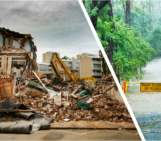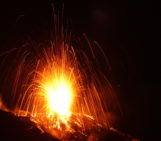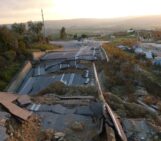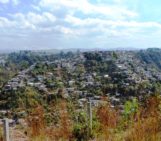
I am pleased to interview Professor Ankit Agarwal from the Indian Institute of Technology, Roorkee. He specialises in hydro-meteorological (compound) extremes and complex networks and has been awarded the prestigious 2023 NH Division Outstanding Early Career Scientist award. Thank you, Ankit, for your time and for talking with us about your field of research.
1. Can you tell us more about your research? What has shaped your research interest over the years?
My scientific research work is centred on decomposing complexity (complexity science) for better understanding, quantifying and predicting hydroclimatic extremes related to Natural Hazards. Very vividly, we cannot use yesterday’s tools to address today’s challenges to identify solutions that one foresees to work tomorrow. In congruence, we developed our own vision that merges non-linear dynamics with hydrometeorology to understand the space-time dynamics of coupled systems and to better forecast climate-related extremes. A central element of our vision is multi-scale Complex Network approaches. We have developed several novel methods, viz. multi-scale event synchronisation and wavelet multi-scale correlation for quantifying interactions at different time scales. They allowed us to demonstrate the importance of multi-scale interactions within climatology and hydrometeorology, further improving the quantification and prediction.

Professor Ankit Agarwal
Several factors have shaped my research interests; my academic background in Civil and Water Resources Engineering fuelled my curiosity to explore the increasing stress on Water Resources and Society and the need for sustainable solutions. I have been provided with a strong foundation in theoretical understanding, coding and mathematics. My PhD at the Potsdam Institute for Climate Impact Research, Helmholtz Centre for Geosciences further strengthened my understanding of complexity sciences, data sciences, process understanding and its applications in Hydrometeorology. Over the years, in collaboration with other researchers and my students, we have established our own research group, HydroClimX, at the Department of Hydrology, Indian Institute of Technology Roorkee. This group focuses on four key areas: A) Methodological Advancements, B) Physical Understanding, C) Societal Relevance, and D) Capacity Building. In addition, we offer engineering solutions to complex problems pertaining to design, water scarcity, extremes and operational forecasting. These factors combined have shaped my research interests in understanding of climate change impacts on hydrological systems and finding sustainable solutions to address these challenges.
2. In your studies, you focused on disentangling increasing compound extremes. Considering the complex nature of extreme events and their interactions, how did you address the potential confounding factors in your analysis and Were there any specific challenges you encountered in disentangling the compound extremes?
Our study in “Scientific Reports” evaluate the change in frequency and spatial extent of compound dry and hot extremes (CDHE). Our recent study in “Atmospheric Research” confirms that the likelihood of CDHE has a strong spatial diversity due to positive feedback between low precipitation, soil moisture deficit, and high temperature. For example, low precipitation leads to soil moisture deficits, which causes the land surface to become hotter. Dry soil absorbs less heat energy than moist soil, which leads to higher temperatures, and higher temperatures can further reduce soil moisture through evapotranspiration, creating a feedback loop where low precipitation leads to low soil moisture and higher temperatures.
To mitigate potential biases associated with the IMD-based data, we included data from multiple sources, including datasets developed by the University of East Anglia and the University of Delaware. The consistency of the observed patterns across these different datasets further strengthens the robustness of our findings. In addition, within the scientific literature, the coupling between soil moisture and temperature has been identified as a potential mechanism contributing to CDHE. Our findings align with the existing literature, and the robustness of our conclusions.
…we cannot use yesterday’s tools to address today’s challenges to identify solutions that one foresees to work tomorrow
In our comprehensive analysis, we identified specific challenges that were overlooked in previous studies. One such challenge was the spatial diversity of Indian rainfall, which had not been adequately considered. Additionally, the intra-seasonality of the Indian Summer Monsoon season was not taken into account. To address these issues, our manuscript in “Scientific Reports” incorporated the spatial and temporal variability of precipitation.
To tackle the spatial diversity challenge, we classified the region into ten homogeneous regions based on climate variability at different time scales rather than relying solely on mean climate conditions. These homogeneous regions exhibit coherence in terms of common seasonality, climate sensitivity, and the global mechanisms that drive variability in different regions (published in “Journal of Hydrology”). These identified homogeneous regions were then used to investigate the characteristics of CDHE from June to September, effectively addressing the spatial diversity and intra-seasonality challenges.
3. In your study on hydrologic regionalisation using the wavelet-based multiscale entropy method, you demonstrated its effectiveness in capturing the complexity and variability of hydrological processes at multiple scales. How does the wavelet-based multiscale entropy method compare to other regionalisation approaches in terms of its ability to capture spatial and temporal variability in hydrological processes?
Certainly! The Wavelet-based Multiscale Entropy (WME) technique is a powerful method for assessing the complexity of hydrological processes across various time scales. It combines two established methods: wavelet transforms and entropy. Wavelet transforms allow the decomposition of hydrological data into different components, enabling the detection of periodicities and variations at different temporal scales. On the other hand, entropy provides valuable insights into energy distribution across these scales, effectively quantifying the inherent complexity of hydrological processes.
While traditional entropy measures offer a single-scale analysis of hydrological processes, real-world applications often involve complex interactions at multiple time scales. In this context, the WME approach excels at uncovering patterns that may go unnoticed in a single-scale analysis. Compared to other existing regionalisation approaches like the method of residuals, the region of influence, and principal component analysis, WME stands out by capturing patterns occurring at different temporal resolutions. It achieves this by identifying and incorporating multi-scale information, which is not feasible with other methods. As a result, WME provides a more comprehensive understanding of the spatial and temporal variability inherent in hydrological processes.
4. Your research on “climate change and risk perceptions among farmer types” is very fascinating. Are there any specific socio-economic, cultural, or geographical factors that contribute to differences in climate change perception, and how might these variations influence adaptive capacity and responses to climate change impacts among different farmer types?
As farmers were categorised based on their resource characteristics and farming preferences, it became evident that their viewpoints were shaped by various factors beyond environmental conditions. Market integration, household size, ethnicity, and gender were critical determinants of farmers’ adaptive capacity. The study also highlighted the moderate role of land size in mountainous areas, where fragmented land poses additional challenges. Farmers who were more integrated into markets, having access to diverse buyers and resources, demonstrated greater resilience in the face of climate challenges. Similarly, households with larger family sizes often possessed greater labour resources, enabling them to adapt and cope with changing conditions more effectively. Understanding these nuances enables equitable planning.

Professor Ankit Agarwal with his students
5. Can you please tell me the main conclusions of the work titled “Disentangling the Characteristics and Drivers of Compound Drought and Hot Extremes” you presented during the EGU NH Medal Lecture?
I was honoured to present my Division Outstanding Early Career Scientist Award lecture at EGU2023. Our research findings show that extreme weather events are interrelated. This means that modelling and predicting individual variables may underestimate the risk of compound events, and the current framework may not be sufficient to fully characterise their impact. Our research makes two significant contributions: methodological and physical understanding. Firstly, we found that compound dry and hot extremes (CDHE) have become 2-3 times more frequent and widespread in the Indian subcontinent during the Indian Summer Monsoon (JJAS) compared to the base period before the climate shift in 1976-1977. The likelihood of CDHE has a strong spatial diversity due to positive feedback between low precipitation, soil moisture deficit, and high temperature. For example, low precipitation leads to soil moisture deficits, which causes the land surface to become hotter. Dry soil absorbs less heat energy than moist soil, which leads to higher temperatures, and higher temperatures can further reduce soil moisture through evapotranspiration, creating a feedback loop where low precipitation leads to low soil moisture and higher temperatures. Secondly, our research highlights a crucial message to the scientific community: the likelihood of CDHE occurrence depends heavily on the strength and type of dependence between precipitation and temperature. Overall, our research emphasises the importance of understanding compound extreme events and the need for improved methods to predict and prepare for their impact.
…we can learn and grow multifold if imbalance could be minimised and equal opportunities could be created for everyone
6. As a professor who is known for prioritising student-centred education and demonstrating a strong commitment to providing scientific opportunities for researchers in less privileged regions worldwide, what has motivated you to advocate for equal opportunities and work towards bridging the gap in scientific resources and access and what are the main activities you are following in this term?
Thanks for recognising the efforts to provide equal scientific opportunities for researchers in less privileged regions worldwide. I believe we can learn and grow multifold if imbalance could be minimised and equal opportunities could be created for everyone. I am particularly concerned about those left behind rather than the issue of brain drain. Finding ways to bring better opportunities and resources to less privileged regions is crucial, as failing to do so would lead to another man-made catastrophic extreme that we must address.
In pursuit of these goals, I am currently engaged in various activities to bring science to researchers in less privileged regions, particularly in India and other countries. These activities include:
- Providing exceptional teaching and training: I am dedicated to delivering the best quality education and training to students, preparing them to compete globally. As a result of our efforts, many of these students have achieved outstanding performance at the international level, securing prestigious awards, scholarships, and grants. This boosts their confidence and equips them to excel in the global scientific arena.
- Leveraging networks and contacts: I actively utilise my network and connections to create opportunities for our students. For example, I have made significant contributions to assisting our institute in developing international collaborations through the coordination of Memoranda of Understanding (MoUs) and agreements. These collaborations provide improved resources and valuable exchange opportunities for our students.
- Facilitating two-way exchanges: It is essential to ensure that exchange programs are not one-sided, focusing solely on outgoing opportunities. I strive to establish reciprocal exchanges where researchers from less privileged regions can benefit from incoming collaborations. This enables a mutual flow of knowledge and experiences, enriching the scientific community.
- Teaching and training students from less privileged regions: Within the Department of Hydrology at IIT Roorkee, we are actively involved in teaching and training numerous students from less privileged regions around the world. For instance, I supervise students from Ethiopia and have provided training to hydro-meteorologists in Myanmar, supported by funding from the WMO (World Meteorological Organization).
- Mentoring Young Minds: A significant portion of my time is devoted to mentoring and imparting scientific knowledge to interns from tier-2 or tier-3 institutes with limited resources for research. By providing guidance and support to these aspiring researchers, I strive to bridge the gap in scientific opportunities and empower them to pursue their academic and professional goals.
By bridging the gap in scientific resources and access, I strongly believe we can foster inclusivity, promote diversity, and address pressing global challenges collaboratively.
Post edited by Shreya Arora and Asimina Voskaki




